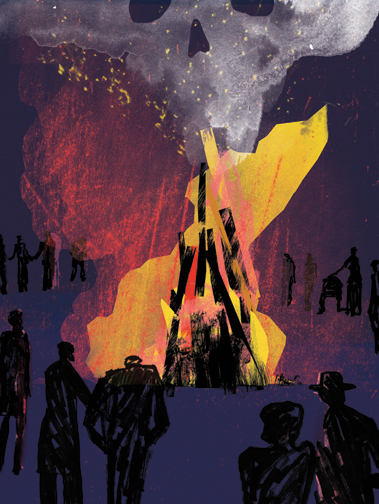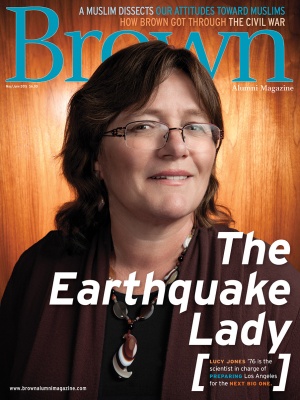The Civil War was deeply traumatic for Brown, as it was for every community in the country—especially communities that were populated, as Brown’s was, by young men. In its earliest years, the tiny Brown campus was so near to the skirmishes of the American Revolution that the enemy could be seen from the rooftop of University Hall. During the Civil War, the battlefields were more distant, but the war touched home in every way.

Unimpressed, the student was put off by Lincoln’s “grotesque and uncouth” manner and some of his Western irreverence (“He made faces at the audience when asked questions not always pertinent”). A week later, on March 8, Lincoln spoke in Woonsocket, and ninety Brown students went to hear him, singing a drinking song along the way (“Here’s to Abe Link, drink him down”).
A year later, Lincoln was president, trying to keep the country intact even as most of the South was seceding. Fort Sumter fell on April 12, and, as news filtered to Providence, emotions ran very high. On April 15, Lincoln issued his call for 75,000 volunteers, and Brown’s seniors asked for permission to raise a large flag over University Hall. A lone voice dissented, from a Mississippian (John J. Ward, class of 1861), who asked that the flag of the Confederacy also be flown—his proposal was of course rejected. A student who was there said that “having recorded his vote, he seceded.” Eventually, he found his way back to Mississippi, where he entered the Confederate army. Three years later, he died in service to his cause from a gunshot wound to his knee, followed by scrofula.
The flag was unfurled on April 17, before a large crowd, with speeches and intense expectations for the contest to come. It was coming up very quickly indeed. Regiments were forming around Rhode Island, and they began to leave from Fox Point the next day to defend Washington. Once again, the roof of University Hall afforded a view of soldiers going to war. In May, a military company was formed at Brown. It was first called, with a bit of academic pretension, “The Wrath of Achilles,” but wiser heads prevailed, and the name was changed to the University Cadets. Resplendent in their new self-designed uniforms, with dark blue shirts, light blue Zouave pants, and red caps, the Cadets paraded at the Class Day on June 13. A little over a month later, the first real battle of the war took place outside Washington, at Bull Run, and Brown students, until recently worrying about their exams, were there. One of them, Leland Jenckes, class of 1861, was wounded and captured, and could not attend his own graduation in September because he was a Confederate prisoner of war.
An older alumnus, Sullivan Ballou, was not as fortunate. Ballou had conquered a number of obstacles in his life even before coming to Brown, including orphanhood. After his graduation in 1852, he forged an impressive career as a local leader. He was elected to the Rhode Island Assembly and became its speaker in due course. He joined the infant Republican Party, helping to promote the unlikely candidacy of Abraham Lincoln. After Lincoln’s call for volunteers, Ballou immediately enlisted and was given the rank of major, third in command of the Second Rhode Island Infantry Regiment. At Bull Run he found himself in the thick of the action and was mortally wounded when a cannonball sheared off part of his right leg. The rest of the leg was amputated, and he was left to die on the battlefield, which he did a week later. Although he was buried by Union soldiers, the battlefield was soon occupied by troops from Georgia, who dug up the Union dead, decapitated them, and burned their bodies. Northern sensibilities were shocked by this act of desecration.
With considerable emotion, Ballou’s remains were retrieved, returned to Rhode Island, and reburied in Swan Point Cemetery. After his death, a letter to his wife was found in his personal effects, hinting at the doom he felt on the eve of battle. Exquisitely written, it was then delivered to her. One can only imagine her feelings upon receiving it. One hundred twenty-nine years later, the reading of this letter caused a sensation during the televised history of the Civil War presented by Ken Burns, the most watched series in the history of public television when it aired in 1990. A few excerpts follow:
My dear Sarah,
. . . . If it is necessary that I should fall on
the battlefield for my country, I am ready. I have no misgivings about,
or lack of confidence in, the cause in which I am engaged, and my
courage does not halt or falter. I know how strongly American
Civilization now leans upon the triumph of the Government and how great
a debt we owe to those who went before us through the blood and
sufferings of the Revolution. And I am willing—perfectly willing—to lay
down all my joys in this life, to help maintain this Government, and to
pay that debt. But, my dear wife, when I know that with my own joys I
lay down nearly all of yours, and replace them in this life with cares
and sorrows—when, after having eaten for long years the bitter fruit of
orphanage myself, I must offer it as their only sustenance to my dear
little children—is it weak or dishonorable, while the banner of my
purpose floats calmly and proudly in the breeze, that my unbounded love
for you, my darling wife and children, should struggle in fierce,
though useless, contest with my love of country?. . .
O Sarah! If the dead can come back to this earth and flit unseen around
those they loved, I shall always be near you—in the garish days and the
darkest nights . . . amidst your happiest scenes and gloomiest
hours—always, always, and if there be a soft breeze upon your cheek, it
shall be my breath; or the cool air fans your throbbing temple, it
shall be my spirit passing by.
Bull Run extinguished the hopes of the entire country that the conflict might be short and decisive. Instead, it was to be a grueling war of attrition. But through those four long years, Rhode Island and the Brown community answered the call with honor and great sacrifice. The war never seemed all that far away—the Naval Academy moved to Newport from Annapolis during the war years, and Narragansett Bay was busy with troop transports and other logistical operations. The factories of Providence worked overtime fabricating uniforms, weapons, and tools for the troops. Sisters, wives, and mothers sewed garments, wrote letters, and helped to provide encouragement in every way they could. Moved by the suffering of veterans, wealthy Brown alumni began to plan for a modern hospital in 1863, and five years later, Rhode Island Hospital opened its doors.
A wide variety of Brown students and alumni served, including those who were too old, those who were too young, and those who would take some time to graduate after returning (they ranged from the class of 1825 to the class of 1874). Some came from the wealthy families of Providence (a grandson of Nicholas Brown’s sister, Thomas Poynton Ives, class of 1854, was killed), but most came from the great rank and file of Rhode Island and its environs. There were occasional glimpses of the famous and near-famous, including the brothers-in-law of William Tecumseh Sherman (Thomas Ewing, class of 1856) and Stephen Douglas (James Madison Cutts, class of 1856). John M. Thayer, class of 1841, became a major general under Ulysses Grant, whom he admired greatly. During a speech he gave on campus in September 1863, Thayer predicted that Grant possessed the power and the will to “crush this infernal rebellion.”
But talented Brown men were also serving on the other side. One of Robert E. Lee’s mapmakers was a resourceful graduate named Albert H. Campbell, class of 1847. Confederate records are more difficult to verify, but nineteen Brown men had joined the Confederate ranks by July 30, 1861, and twenty-four would serve afterwards, as surgeons, engineers, and common foot soldiers. One of them was Clarence Bate, class of 1858, who had caused the trouble with the duel in 1857. It speaks of the strangeness of the war to realize that his life was probably spared because of his Brown connection. During the war, he was nearly executed by federal authorities for opening a Confederate recruiting station, only to have President Lincoln intercede with a pardon at the last moment—a pardon most likely engineered by his undergraduate friend John Hay.
A similar strangeness might be found in the story of a hot-tempered Virginian named Martin Luther Laws, who probably served in a Confederate militia in 1861 before deserting, then entered Brown as an undergraduate in the fall of 1863 while the war was still raging. When a frightened freshman asked Laws to defend him from a hazing ritual, Laws pulled out a revolver to shoot the assailant. Fortunately, his hand was jostled, and as an account informs us, the bullet merely grazed the “olfactory protuberance” of the would-be hazer. Laws was sent away for a while but managed to graduate in 1864.
In April 1865, it was over, and Brown students celebrated with an enormous bonfire on April 9, the night Robert E. Lee surrendered at Appomattox. All in all, an astonishing 417 Brown men served in the war, though it took some time to get the records right. Remembering the war was nearly as important as fighting it, and a memorial plaque went up quickly, unveiled in Manning Hall on September 4, 1866. Then, with great care, a lavish memorial publication was issued in 1868, honoring twenty-one young men killed on the Union side, and still bristling with anger over the loss of so many young men.
Over the next generation, the veterans would return to campus with a tragic wisdom that no professor could ever impart. With time, Brown would remember all of its young men who had fought, including those who fought for the Confederacy. Henry Burrage, class of 1861, the same young man who kept a journal of his student life in the spring of 1861, when the war was starting, and then compiled the memorial book of 1868, lived long enough to bring out a new edition in 1920, when passions had subsided. In that book, less ornate but more temperate, he included the names of everyone from Brown who had fought. By that time, he counted thirty-nine who had been killed. In his final version of the roll, Burrage broadened his definition of service to include not only those who fought but also those who performed other kinds of patriotic duty—including Brown’s former president, Francis Wayland, who worked to open a veterans home. That larger definition was appropriate, for the tragedy of the war had touched everyone in the Brown community, directly or indirectly.
Former director of the John Carter Brown Library and a former senior adviser to Secretary of State Hillary Clinton, Ted Widmer has written or edited many works of history, including the Library of America’s American Speeches: Political Oratory from the Revolution to the Civil War. This essay is excerpted from Brown: The History of an Idea, published in May and available from the Brown Bookstore.
Illustration by Luke Best.





